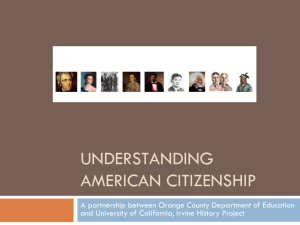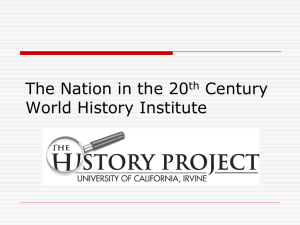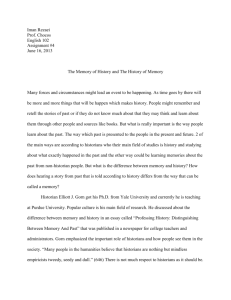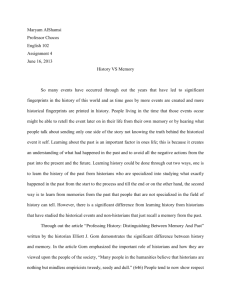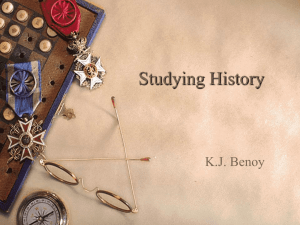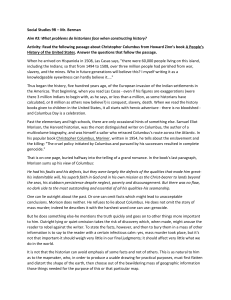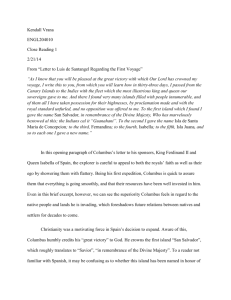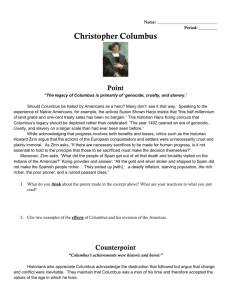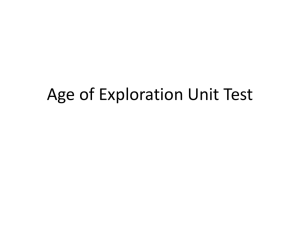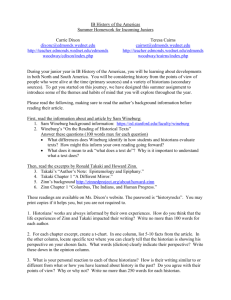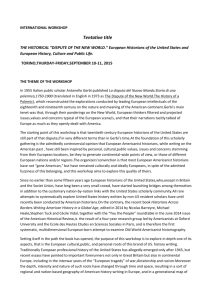Thinking as a Historian - School of Humanities
advertisement
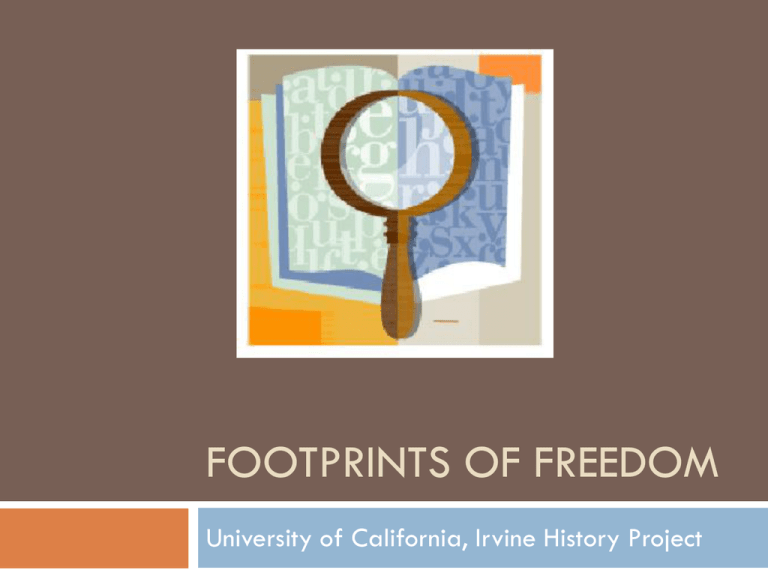
FOOTPRINTS OF FREEDOM University of California, Irvine History Project UCI History Project California Subject Matter Project (CSMP) The California History-Social Science Project is an organization of teachers, historians, and affiliated scholars that promotes history and social science education through advocacy, professional development programs, and leadership opportunities. We employ a research-based approach that focuses on the disciplinary skills of history and the social sciences, on content aligned with the Standards, and on academic literacy. Our goal is to increase the achievement of all students, thereby developing an informed and engaged citizenry. Goals Increase teacher knowledge of history Deepen understanding to improve instruction Build a sustainable model Curricular reform Standards-aligned lessons Academic literacy instruction Support for critical thinking Icebreaker Puzzle Activity Find their group via puzzle pieces Introduce yourself Observe the image and describe it as a group Consider what conclusions or questions you have about the image History as a Discipline What is history? History is a representation of the past based upon interpretations of evidence (primary and secondary sources) available. Therefore, history is constructed knowledge. Why do history? History is not static. Historical representations change over time. New evidence comes to light Changes in technology Present concerns inform the ways historians think about the past As theories change, historians review existing evidence. Pose new questions. Historical thinking How do you define history for your students? Quick write Pair Share How do students typically view history? Students see history as the construction and memorization of a “factoid narrative.” Many see history as a finished story. It is names, dates, and places. See history as linear (one thing after another) and progressive (things are getting better) Students struggle with explaining change over time and recognizing significance. Students also magnify the role of individuals. Students often personify history--For example, China becomes a person. Fail to see the relevance of history Historical Thinking and Other Unnatural Acts Sam Wineburg Why study history? Understanding of humanity, complexity, critical thinking skills Read the excerpt The Unbridgeable Rubicon and Continuity and Change pp.7-15 Jigsaw Number off 1-5 1-How is Derek’s analysis an expression of historical empathy (page 8)? Why is empathy important for history? 2-What do contemporary historians believe we can know about the past (pages 10-11)? 3-What are the challenges of learning history from textbooks (pages 12-13)? 4-How does Ulrich’s A Midwife’s Tale contrast to textbook history (pages 13-15)? 5-How has historical writing changed in the last decades (page 15)? All like numbers gather together and discuss your question Form groups with numbers 1-5 and share out each of your answers with the group Historical Thinking Historians in the Field Students in the Classroom Ask research questions based upon new and existing information Students form and/or answer research questions of the lesson’s content Teachers Use primary and secondary sources to construct knowledge Students use primary and secondary sources to make reasoned interpretations and construct knowledge Why use historical thinking in teaching? Inquiry based approach Builds on prior knowledge Motivates student learning In-depth understanding Prioritizes essential questions Students analyze evidence to construct new meanings Develops critical thinking skills and academic literacy History-Social Science Analysis Skills Review the thinking skills for your grade-level Consider how these skills develop the historical thinking skills described in Wineburg’s text Curriculum Analysis In school site groups, examine the content standards for your grade level Develop 3-4 large-scale themes that cover the entire curriculum Share out across grade-levels PRIMARY OR SECONDARY SOURCE adapted from History Project at UC Davis Definition According to the Library of Congress, primary sources are the raw materials of history — documents and objects which were created at the time under study. They are different from secondary sources - accounts or interpretations of events created by someone without firsthand experience. Video Clip Primary vs. Secondary Some additional thoughts Primary sources are materials produced by people or groups directly involved in the event or topic under consideration. Think of them as first-hand information. Examples of primary sources include eyewitness accounts, speeches, letters and diaries, newspapers and magazines, tax and census data, marriage, birth and death records, works of art, and interviews. Secondary sources Secondary sources construct an explanation of the past based on primary sources and usually in consultation with other secondary sources. The best secondary sources will both report on events in the past as well as generalize, analyze, interpret and/or evaluate. TITLE: Epistola . . . de Insulis Indie nuper inventis (Letter Concerning the Islands Recently Discovered…) “There I found very many islands, filled with innumerable people, and I have taken possession of them all for their Highnesses, done by proclamation and with the royal standard unfurled, and no opposition was offered to me.” CREATED/PUBLISHED by Christopher Columbus (1451-1506) in Rome, 1493. Rare Book and Special Collections Division, Library of Congress Available at: http://www.loc.gov/exhibits/treasures/trt038.html TITLE: Columbus taking possession of the new country. CREATED/PUBLISHED: Boston, U.S.A. : Published by the Prang Educational Co., 1893. 1 print : chromolithograph. Prints and Photographs Division, Library of Congress Available at: http://lcweb2.loc.gov/cgibin/query/i?pp/PPALL:@field%28NUMBER+@band%28cph+3b49587%29%29 On a summer day in 1492, Columbus set sail for Spain into the uncharted seas with three small ships. After more than a month at sea, crew members sighted land—one of the Bahama islands in the Caribbean. In honor of Christ, Columbus named the land San Salvador, which is Spanish for “holy savior.”…Convinced that he had reached islands off the coast of India, Columbus called the natives “Indians.” --World History: Traditions and New Directions by Peter N. Stearns, Donald R. Schwartz, and Barry K. Beyer published in 1991 by Addison-Wesley Publishing Complexity Sources may be both primary and secondary— depending on your topic or question. Student work If you choose do 10th grade first form high-need OC high schools 10th grade Then 5th from Lynwood TAH Stations Around the room there are 5 stations with sources from different time periods. Your task is to determine if each source is primary or secondary and why. If there are secondary sources, under what conditions could they be considered primary? WHAT TOOLS ARE AVAILABLE TO HELP STUDENTS BREAK DOWN A PRIMARY SOURCE? “Give us the tools, and we will finish the job.” THE 6 C’S!! What are we looking for the students to accomplish? An accurate summary of the source provided (who, what, where…) Accurate /thoughtful connections made between source and what was happening at that time and place in history. Bias and point of view are clearly identified. Students support their claims with specific examples from source. It is clear as to who created this source, when it was written, and what type of source it is. Interesting and thoughtful connections made between the source and what the students already know, or what they can relate it to. Student provides a thoughtful conclusion that closely connects to source How can the 6C’s be practiced in the classroom? Students might begin with 4 C’s Students work in cooperative groups (3-4 members), with each group responsible for using one of the 6C’s to analyze the source. Each group then shares with the class their analysis of the source, and the other students fill in the sections of the 6 C’s as they are discussed by each group. Students work in cooperative groups (3 members). Each student within the group is responsible for completing two sections of the 6 C’s. They then share their responses with the other group members. Groups are then selected to share their responses with the class. For January meeting Implement 4 C’s or 6 C’s with a primary source Bring student work high, medium, low Read Wineburg Chapter 1 (entire)
